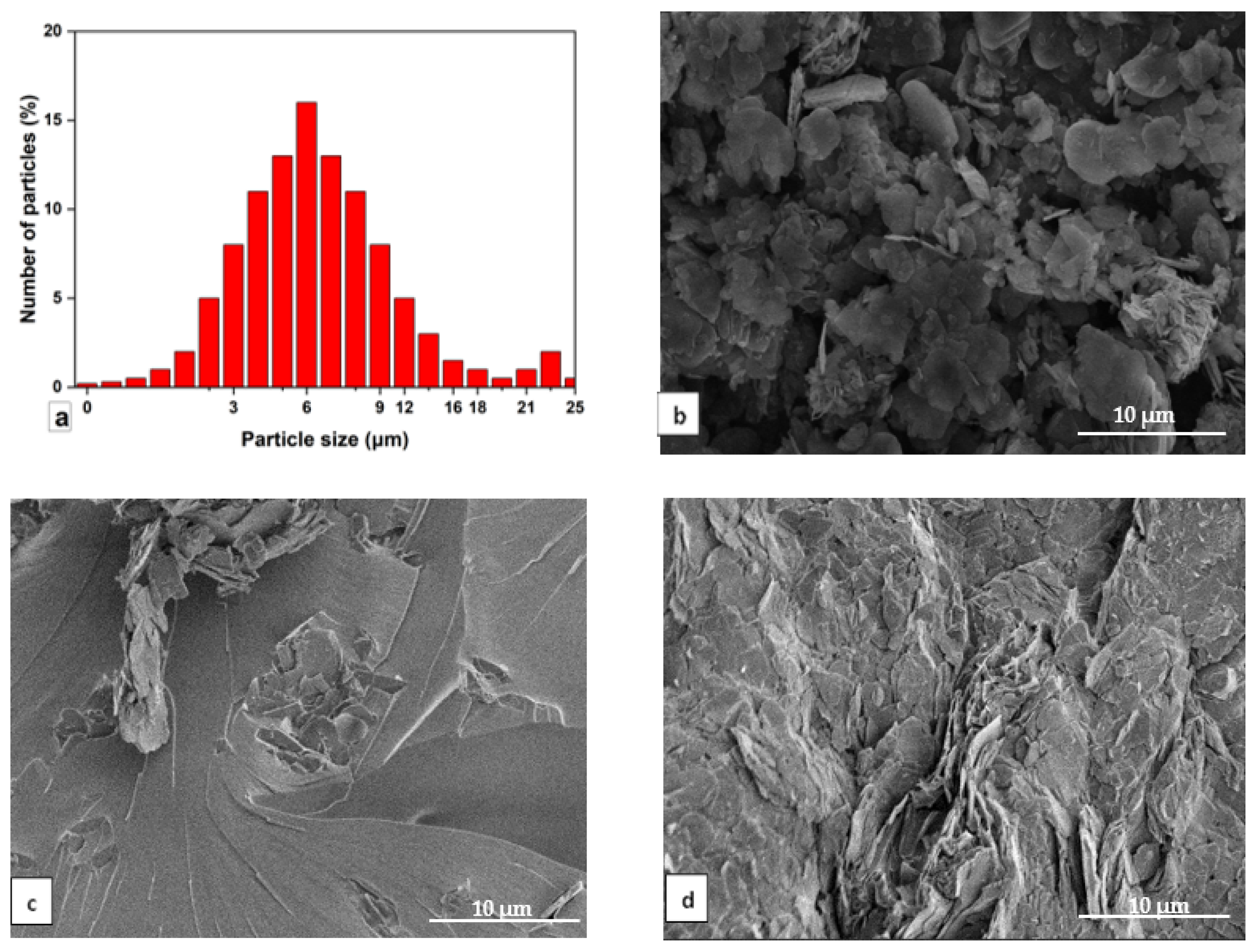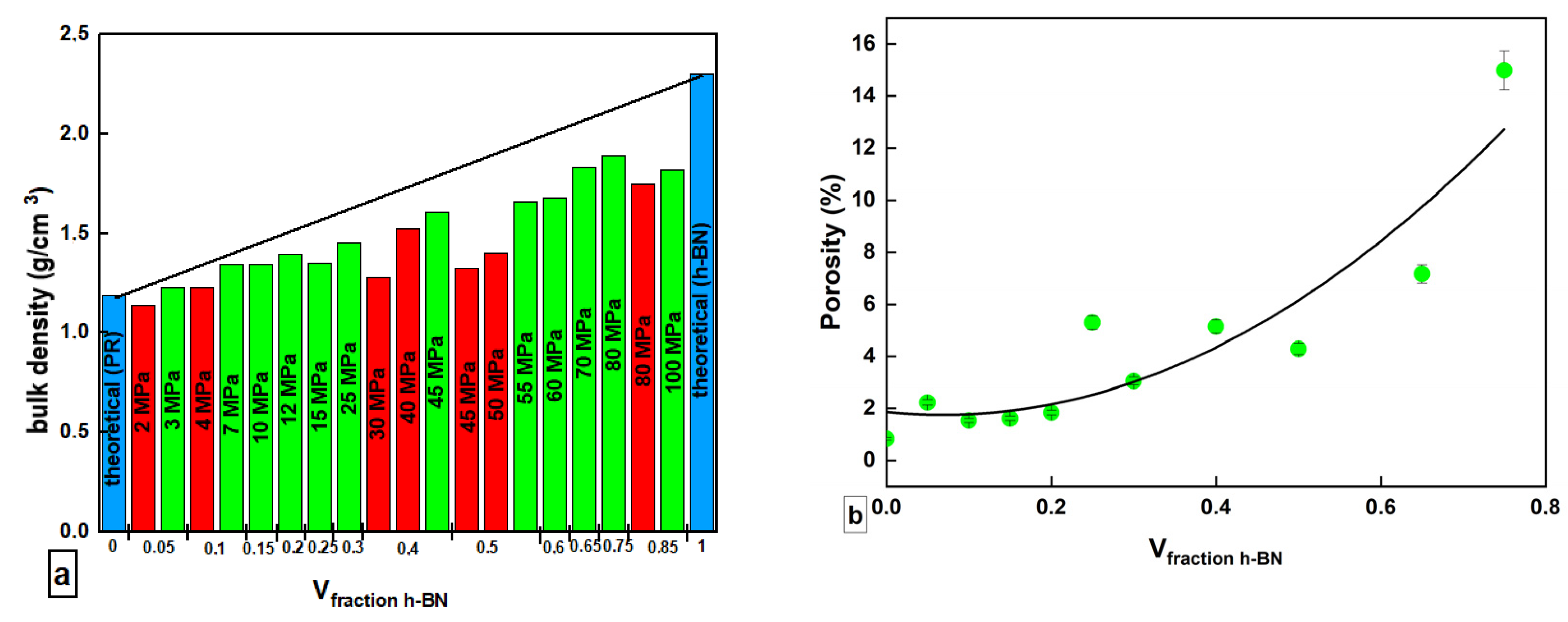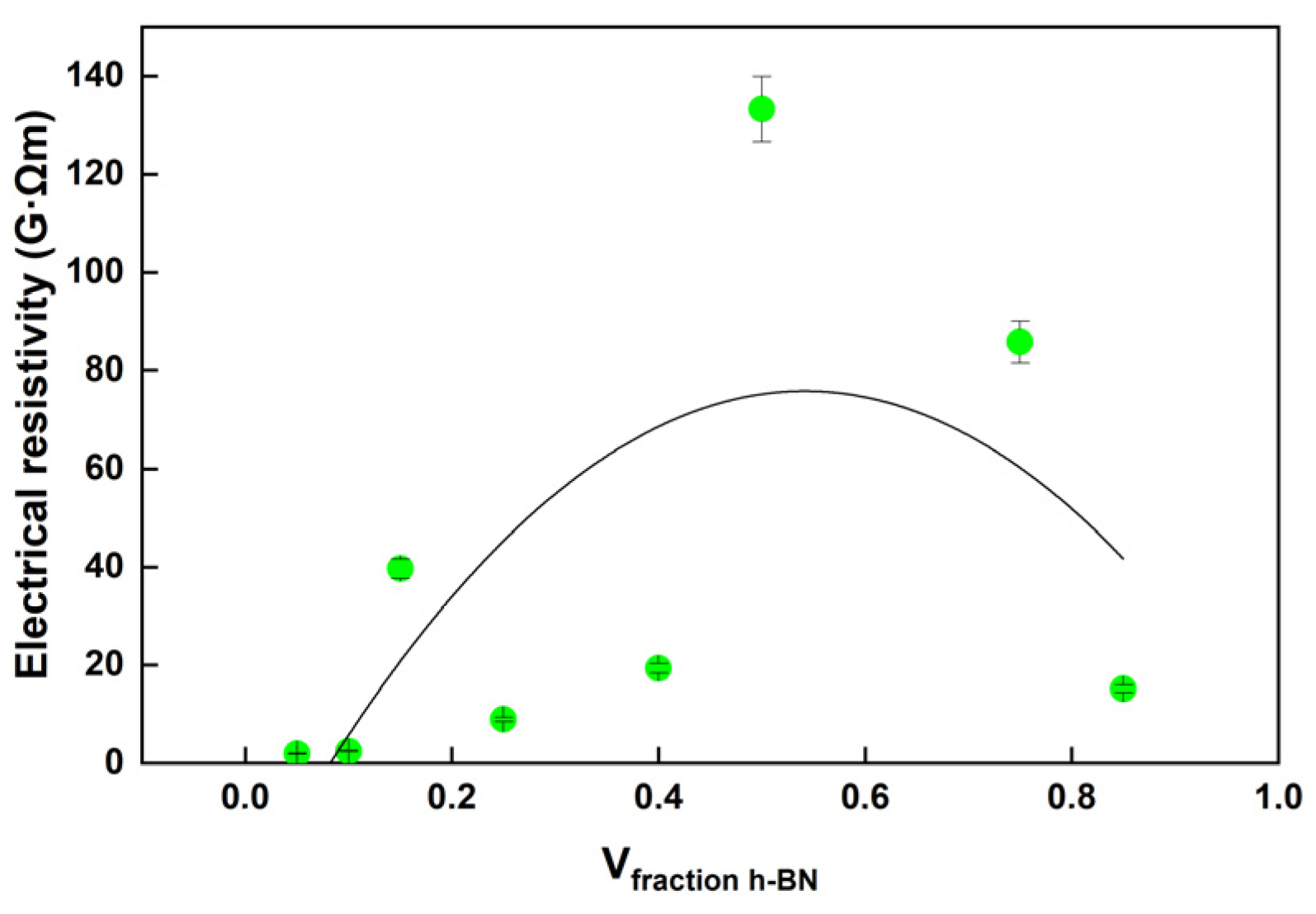Excellent Thermal and Dielectric Properties of Hexagonal Boron Nitride/Phenolic Resin Bulk Composite Material for Heatsink Applications
Abstract
:1. Introduction
2. Materials and Methods
2.1. Manufacturing of h-BN/PR Composites
2.2. Characterization Techniques
3. Results and Discussion
3.1. Filler Particle Size Distribution
3.2. h-BN/PR Composites Manufacturing Technology
3.3. Thermal Conductivity Analysis
3.4. Thermogravimetric Analysis and Thermal Stability
3.5. Dielectric Properties
3.6. Mechanical Properties
4. Conclusions
Author Contributions
Funding
Data Availability Statement
Acknowledgments
Conflicts of Interest
References
- Feng, C.P.; Yang, L.Y.; Bai, L.; Bao, R.Y.; Liu, Z.Y.; Yang, M.B.; Lan, H.B.; Yang, W. Recent advances in polymer-based thermal interface materials for thermal management: A mini-review. Compos. Commun. 2020, 22, 100528. [Google Scholar] [CrossRef]
- Prasher, R. Thermal interface materials: Historical perspective, status, and future directions. Proc. IEEE 2006, 94, 1571–1586. [Google Scholar] [CrossRef]
- Zhang, Y.; Ma, J.; Yang, J.; Pei, Q.X. Recent progress in the development of thermal interface materials: A review. Phys. Chem. Chem. Phys. 2021, 23, 753–776. [Google Scholar] [CrossRef] [PubMed]
- Ma, H.; Gao, B.; Wang, M.; Yuan, Z.; Shen, J.; Zhao, J.; Feng, Y. Strategies for enhancing thermal conductivity of polymer-based thermal interface materials: A review. J. Mater. Sci. 2021, 56, 1064–1086. [Google Scholar] [CrossRef]
- Tong, X.C. Advanced Materials for Thermal Management of Electronic Packaging; Springer Series in Advanced Microelectronics; Springer: Berlin/Heidelberg, Germany, 2011; Volume 30, pp. 1–616. [Google Scholar]
- Cheng, S.; Li, Y.S.; Liang, J.J.; Li, Q. Polymer dielectrics and their nanocomposites for capacitive energy storage applications. Acta Polym. Sin. 2020, 51, 469–483. [Google Scholar]
- Hansson, J.; Nilsson, T.M.J.; Ye, L.; Liu, J. Novel nanostructured thermal interface materials: A review. Int. Mater. Rev. 2017, 63, 22–45. [Google Scholar] [CrossRef]
- Huang, C.; Qian, X.; Yang, R. Thermal conductivity of polymers and polymer nanocomposites. Mater. Sci. Eng. R Rep. 2018, 132, 1–22. [Google Scholar] [CrossRef] [Green Version]
- Cevallos, J.G.; Bergles, A.E.; Bar-Cohen, A.; Rodgers, P.; Gupta, S.K. Polymer heat exchangers—History, opportunities, and challenges. Heat Transf. Eng. 2012, 33, 1075–1093. [Google Scholar] [CrossRef]
- Vavidelu, M.A.; Kumar, C.R.; Joshi, G.M. Polymer composites for thermal management: A review. Compos. Interfaces 2016, 23, 847–872. [Google Scholar]
- Pan, X.; Debije, M.G.; Schenning, A.P.H.J. High thermal conductivity in anisotropic aligned polymeric materials. ACS Appl. Polym. Mater. 2021, 3, 578–587. [Google Scholar] [CrossRef]
- Krásny, I.; Astrouski, I.; Raudensky, M. Polymeric hollow fiber heat exchanger as an automotive radiator. Appl. Therm. Eng. 2016, 108, 798–803. [Google Scholar] [CrossRef]
- Timbs, K.; Khatamifar, M.; Lin, W.; Antunes, E. Experimental study on the thermal performance of straight and oblique finned, polymer heat sinks. In Proceedings of the 22nd Australasian Fluid Mechanics Conference AFMC2020, Brisbane, Australia, 7–10 December 2020. [Google Scholar]
- Marchetto, D.B.; Moreira, D.C.; Ribatski, G. A Review on polymer heat sinks for electronics cooling applications. In Proceedings of the 17th Brazilian Congress of Thermal Sciences and Engineering, Águas de Lindóia, SP, Brazil, 25–28 November 2018. [Google Scholar]
- Chen, X.; Su, Y.; Reay, D.; Riffat, S. Recent research developments in polymer heat exchangers—A review. Renew. Sustain. Energy Rev. 2016, 60, 1367–1386. [Google Scholar] [CrossRef]
- Agrawal, A.; Chandrakar, S.; Sharma, A. Mechanical and thermal behaviour of epoxy/hexagonal boron nitride/short sisal fiber hybrid composites. IOP Conf. Ser. Mater. Sci. Eng. 2020, 840, 012011. [Google Scholar] [CrossRef]
- Yang, R.; Sheng, M.; Zhang, Y.; Gong, H.; Lin, X.; Pei, Y.; Zhang, X. Thermal and dielectric properties of epoxy-based composites filled with flake and whisker type hexagonal boron nitride materials. High. Perform. Polym. 2021, 33, 417–428. [Google Scholar] [CrossRef]
- Zhang, Y.; Gao, W.; Li, Y.; Zhao, D.; Yin, H. Hybrid fillers of hexagonal and cubic boron nitride in epoxy composites for thermal management applications. RSC Adv. 2019, 9, 7388–7399. [Google Scholar] [CrossRef] [PubMed]
- Zhou, W.; Zuo, J.; Zhang, X.; Zhou, A. Thermal, electrical, and mechanical properties of hexagonal boron nitride–reinforced epoxy composites. J. Compos. Mater. 2013, 48, 2517–2526. [Google Scholar] [CrossRef]
- Gu, J.; Meng, X.; Tang, Y.; Li, Y.; Zhuang, Q.; Kong, J. Hexagonal boron nitride/polymethyl-vinyl siloxane rubber dielectric thermally conductive composites with ideal thermal stabilities. Compos. Part. A Appl. Sci. Manuf. 2017, 92, 27–32. [Google Scholar] [CrossRef]
- Zhan, Y.; Long, Z.; Wan, X.; Zhan, C.; Zhang, J.; He, Y. Enhanced dielectric permittivity and thermal conductivity of hexagonal boron nitride/poly(arylene ether nitrile) composites through magnetic alignment and mussel inspired co-modification. Ceram. Int. 2017, 43, 12109–12119. [Google Scholar] [CrossRef]
- Tang, Y.; Zhang, P.; Zhu, M.; Li, J.; Li, Y.; Wang, Z.; Huang, L. Temperature effects on the dielectric properties and breakdown performance of h-BN/epoxy composites. Materials 2019, 12, 4112. [Google Scholar] [CrossRef] [Green Version]
- Fu, X.; Guo, Y.; Du, Q.; Guan, L.; He, S. Improved dielectric stability of epoxy composites with ultralow boron nitride loading. RSC Adv. 2019, 9, 4344–4350. [Google Scholar] [CrossRef]
- Kochetov, R.; Andritsch, T.; Morshuis, P.H.F.; Smit, J.J. Effect of filler size on complex permittivity and thermal conductivity of epoxy-based composites filled with BN particles. In Proceedings of the 2010 Annual Report Conference on Electrical Insulation and Dielectic Phenomena, West Lafayette, IN, USA, 17–20 October 2010; p. 5723962. [Google Scholar]
- Zhang, D.L.; Liu, S.N.; Cai, H.W.; Feng, Q.K.; Zhong, S.L.; Zha, J.W.; Dang, Z.M. Enhanced thermal conductivity and dielectric properties in electrostatic self-assembly 3D pBN@nCNTs fillers loaded in epoxy resin composites. J. Mater. 2020, 6, 751–759. [Google Scholar] [CrossRef]
- Chiang, T.H.; Hsieh, T.E. A study of encapsulation resin containing hexagonal boron nitride (hBN) as inorganic filler. J. Inorg. Organomet. Polym. Mater. 2006, 16, 175–183. [Google Scholar] [CrossRef]
- Yu, Z.; Wang, X.; Bian, H.; Jiao, L.; Wu, W.; Dai, H. Enhancement of the heat conduction performance of boron nitride/cellulosic fibre insulating composites. PLoS ONE 2018, 13, e0200842. [Google Scholar] [CrossRef]
- Takahashi, S.; Imai, Y.; Kan, A.; Hotta, Y.; Ogawa, H. Dielectric and thermal properties of isotactic polypropylene/hexagonal boron nitride composites for high-frequency applications. J. Alloys Compd. 2014, 615, 141–145. [Google Scholar] [CrossRef]
- Yuan, F.Y.; Zhang, H.B.; Li, X.; Li, X.Z.; Yu, Z.Z. Synergistic effect of boron nitride flakes and tetrapod-shaped ZnO whiskers on the thermal conductivity of electrically insulating phenol formaldehyde composites. Compos. Part. A Appl. Sci. Manuf. 2013, 53, 137–144. [Google Scholar] [CrossRef]
- Wang, Z.; Liu, J.; Cheng, Y.; Chen, S.; Yang, M.; Huang, J.; Wang, H.; Wu, G.; Wu, H. Alignment of boron nitride nanofibers in epoxy composite films for thermal conductivity and dielectric breakdown strength improvement. Nanomaterials 2018, 8, 242. [Google Scholar] [CrossRef] [Green Version]
- Moradi, S.; Calventus, Y.; Román, F.; Hutchinson, J.M. Achieving high thermal conductivity in epoxy composites: Effect of boron nitride particle size and matrix-filler interface. Polymers 2019, 11, 1156. [Google Scholar] [CrossRef] [Green Version]
- Moradi, S.; Román, F.; Calventus, Y.; Hutchinson, J.M. Remarkable thermal conductivity of epoxy composites filled with boron ntride and cured under pressure. Polymers 2021, 13, 955. [Google Scholar] [CrossRef] [PubMed]
- Tominaga, Y.; Hotta, Y.; Imai, Y. Effect of resin chemical structure on the dispersibility of hexagonal boron nitride. Compos. Interfaces 2020, 27, 967–975. [Google Scholar] [CrossRef]
- Yi, L.; Conell, J.W. Advances in 2D boron nitride nanostructures: Nanosheets, nanoribbons, nanomeshes, and hybrids with graphene. Nanoscale 2012, 4, 6908–6939. [Google Scholar]
- Guo, H.; Xu, T.; Zhou, S.; Jiang, F.; Jin, L.; Song, N.; Ding, P. A technique engineered for improving thermal conductive properties of polyamide-6 composites via hydroxylated boron nitride masterbatch-based melt blending. Compos. Part. B Eng. 2021, 212, 108716. [Google Scholar] [CrossRef]
- Weng, Q.; Wang, X.; Wang, X.; Bando, Y.; Golberg, D. Functionalized hexagonal boron nitride nanomaterials: Emerging properties and applications. Chem. Soc. Rev. 2016, 45, 3989–4012. [Google Scholar] [CrossRef] [PubMed] [Green Version]
- Jomon, J.; Elssa, G.; Prakashan, H.; Sabu, T.; Saithalavi, A. An overview of boron nitride based polymer nanocomposites. J. Polym. Sci. 2020, 58, 3115–3141. [Google Scholar]
- Morchat, R.M.; Hiltz, J.A. A TGA study correlating polymer characteristics with smoke and flammability properties of polyester and phenolic resins. Thermochim. Acta 1991, 192, 221–231. [Google Scholar] [CrossRef]
- Asim, M.; Saba, N.; Jawaid, M.; Nasir, M.; Pervaiz, M.; Alothman, O.Y. A Review on phenolic resin and its composites. Curr. Anal. Chem. 2018, 14, 185–197. [Google Scholar] [CrossRef]
- Ghosh, B.; Xu, F.; Hou, X. Thermally conductive poly(ether ether ketone)/boron nitride composites with low coefficient of thermal expansion. J. Mater. Sci. 2021, 56, 10326–10337. [Google Scholar] [CrossRef]
- Choupin, T.; Fayolle, B.; Renier, G.; Paris, C.; Senkin, J.; Brulem, B. Macromolecular modifications of the poly(etherketone ketone) copolymer (PEKK) in the state of melting. Polym. Degrad. Stab. 2018, 155, 103–110. [Google Scholar] [CrossRef]
- Ko, T.H.; Hu, H.L.; Kuo, W.S.; Wang, S.H. Enhancing thermal conductivity and physical properties of phenol-formaldehyde resin by adding VGCF during pyrolysis. J. Appl. Polym. Sci. 2006, 102, 1531–1538. [Google Scholar] [CrossRef]
- Liu, Y.; Nanwang, Y.L.; Lu, H.; Liu, J. Effect of boron nitride particle geometry on the thermal conductivity of a boron nitride enhanced polymer composite film. In Proceedings of the 25th International Workshop on Thermal Investigations of ICs and Systems (THERMINIC), Lecco, Italy, 25–27 September 2019; p. 8923441. [Google Scholar]
- Wu, K.; Fang, J.C.; Ma, J.R.; Huang, R.; Chai, S.G.; Chen, F.; Fu, Q. Achieving a collapsible, strong and highly thermally conductive film based on oriented functionalized boron nitride nanosheets and cellulose nanofiber. ACS Appl. Mater. Interfaces 2017, 9, 30035–30045. [Google Scholar] [CrossRef] [PubMed]
- Song, W.L.; Wang, P.; Cao, L.; Anderson, A.; Meziani, M.J.; Farr, A.J.; Sun, Y.P. Polymer/boron nitride nanocomposite materials for superior thermal transport performance. Angew. Chem. Int. Ed. 2012, 51, 6498–6501. [Google Scholar] [CrossRef] [PubMed]
- Yu, C.; Zhang, J.; Tian, W.; Fan, X.; Yao, Y. Polymer composites based on hexagonal boron nitride and their application in thermally conductive composites. RSC Adv. 2018, 8, 21948–21967. [Google Scholar] [CrossRef]
- Mehra, N.; Mu, L.W.; Ji, T.; Yang, X.T.; Kong, J.; Gu, J.W.; Zhu, J.H. Thermal transport in polymeric materials and across composite interfaces. Appl. Mater. Today 2018, 12, 92–130. [Google Scholar] [CrossRef]
- Yu, L.; Gao, S.; Yang, D.; Wei, Q.; Zhang, L. Improved thermal conductivity of polymer composites by noncovalent modification of boron nitride via tannic acid chemistry. Ind. Eng. Chem. Res. 2021, 60, 12570–12578. [Google Scholar] [CrossRef]
- Chen, L.; Li, K.; Li, B.; Ren, D.; Chen, S.; Xu, M.; Liu, X. Enhanced thermal conductivity of benzoxazine nanocomposites based on non-covalent functionalized hexagonal boron nitride. Compos. Sci. Technol. 2019, 182, 107741. [Google Scholar] [CrossRef]
- Jiang, Y.; Shi, X.; Feng, Y.; Li, S.; Zhou, X.; Xie, X. Enhanced thermal conductivity and ideal dielectric properties of epoxy composites containing polymer modified hexagonal boron nitride. Compos. Part. A Appl. Sci. Manuf. Solid-State 2018, 107, 657–664. [Google Scholar] [CrossRef]
- Lee, E.-S.; Kang, J.-G.; Kang, M.-K.; Kim, K.-H.; Park, S.-T.; Kim, Y.S.; Kim, I.; Kim, S.-D.; Bae, J.-Y. High thermal conductivity of boron nitride filled epoxy composites prepared by tin solder nanoparticle decoration. Compos. Part. B Eng. 2021, 225, 109264. [Google Scholar] [CrossRef]
- Ge, M.; Zhang, J.; Zhao, C.; Lu, C.; Du, G. Effect of hexagonal boron nitride on the thermal and dielectric properties of polyphenylene ether resin for high-frequency copper clad laminates. Mater. Des. 2019, 182, 108028. [Google Scholar] [CrossRef]
- Tang, X.; Guo, Y.; Liao, Z.; Fan, J.; Zhang, K.; Yang, Z. Synergistic enhancement of thermal conductivity between SiC and h-BN in MVQ-based composite. Fuller. Nanotub. Carbon Nanostructures 2019, 27, 434–439. [Google Scholar] [CrossRef]
- Guzej, M.; Zachar, M.; Kominek, J.; Kotrbacek, P.; Brachna, R. Importance of Melt Flow Direction during Injection Molding on Polymer Heat Sinks’ Cooling Efficiency. Polymers 2021, 13, 1186. [Google Scholar] [CrossRef]
- Gu, J.; Lu, Z.; Wu, Y.; Guo, Y.; Tian, L. Dielectric thermally conductive boron nitride/polyimide composites with outstanding thermal stabilities via in-situ polymerization electrospinning-hot press method. Compos. Part. A Appl. Sci. Manuf. 2017, 94, 209–216. [Google Scholar] [CrossRef]
- Yang, X.; Guo, Y.; Zheng, N.; Ma, T.; Tan, J. Self-healing, recoverable epoxy elastomers and their composites with desirable thermal conductivities by incorporating BN fillers via in-situ polymerization. Compos. Sci. Technol. 2018, 164, 59–64. [Google Scholar] [CrossRef]
- Qin, M.; Xu, Y.; Cao, R.; Feng, W.; Chen, L. Efficiently controlling the 3D thermal conductivity of a polymer nanocomposite via a hyperelastic double-continuous network of graphene and sponge. Adv. Funct. Mater. 2018, 28, 1805053. [Google Scholar] [CrossRef]
- Li, Z.; Wang, L.; Li, Y.; Feng, Y.; Feng, W. Carbon-based functional nanomaterials: Preparation, properties and applications. Compos. Sci. Technol. 2019, 179, 10–40. [Google Scholar] [CrossRef]
- Jiang, F.; Zhou, S.; Xu, T.; Ding, P. Enhanced thermal conductive and mechanical properties of thermoresponsive polymeric composites: Influence of 3D interconnected boron nitride network supported by polyurethane@polydopamine skeleton. Compos. Sci. Technol. 2021, 208, 108779. [Google Scholar] [CrossRef]
- Novokshonova, L.A.; Kudinova, O.I.; Berlin, A.A.; Grinev, V.G.; Nezhny, P.A.; Krasheninnikov, V.G. Heat-Conducting Electrically Insulating Composite Material. Patent RU2643985C1, 16 January 2017. [Google Scholar]
- Wang, Z.; Iizuka, T.; Kozako, M.; Ohki, Y.; Tanaka, T. Development of epoxy/BN composites with high thermal conductivity and sufficient dielectric breakdown strength part I—Sample preparations and thermal conductivity. IEEE Trans. Dielectr. Electr. Insul. 2011, 18, 1963–1972. [Google Scholar] [CrossRef]
- Wereszczak, A.A.; Morrissey, T.G.; Volante, C.N.; Farris, P.J.; Groele, R.J.; Wiles, R.H. Thermally conductive MgO-filled epoxy molding compounds. IEEE Trans. Compon. Packag. Manuf. Technol. 2013, 3, 1994–2005. [Google Scholar] [CrossRef]
- Bruggeman, D.A.G. Dielectric constant and conductivity of mixtures of isotropic materials [Original Title: Berechnung verschiedener physikalischer Konstanten von heterogenen Substanzen. I. Dielektrizitätskonstanten und Leitfähigkeiten der Mischkörper aus isotropen Substanzen]. Annal. Phys. 1935, 24, 636–679. [Google Scholar]
- Nikoo, G.; Esfahani, S.; Armin, S.; Milad, M.; Hossein, N. The effect of filler localization on morphology and thermal conductivity of the polyamide/cyclic olefin copolymer blends filled with boron nitride. J. Mater. Sci. 2018, 53, 16146–16159. [Google Scholar]
- Agari, Y.; Uno, T. Estimation on thermal conductivities of filled polymers. J. Appl. Pol. Sci. 1986, 32, 5705–5712. [Google Scholar] [CrossRef]
- Dong, M.; Hou, G.; Zhang, J.; Liu, L.; Liang, G.; Hao, X.; Guo, Y.; Wang, M. Proposal and verification of thermal-conductive model of polymer nanocomposites. Comp. Part. B Eng. 2022, 242, 110033. [Google Scholar] [CrossRef]
- Laturia, A.; Van de Put, M.L.; Vandenberghe, W.G. Dielectric properties of hexagonal boron nitride and transition metal dichalcogenides: From monolayer to bulk. Npj 2D Mater. Appl. 2018, 2, 6. [Google Scholar] [CrossRef] [Green Version]
- Garnett, J.C.M. Colours in Metal Glasses and in Metallic Films. Philos. Trans. Royal Soc. A Math. Phys. Eng. Sci. 1904, 203, 385–420. [Google Scholar] [CrossRef]
- Lucarini, V.; Peiponen, K.E.; Saarinen, J.J.; Vartiainen, E.M. Kramers-Kronig Relations in Optical Materials Research; Springer Series in Optical Sciences; Springer: Berlin/Heidelberg, Germany, 2005; Volume 110, pp. 1–162. [Google Scholar]
- Shtansky, D.V.; Matveev, A.T.; Permyakova, E.S.; Leybo, D.V.; Konopatsky, A.S.; Sorokin, P.B. Recent Progress in Fabrication and Application of BN Nanostructures and BN-Based Nanohybrids. Nanomaterials 2022, 12, 2810. [Google Scholar] [CrossRef] [PubMed]









Disclaimer/Publisher’s Note: The statements, opinions and data contained in all publications are solely those of the individual author(s) and contributor(s) and not of MDPI and/or the editor(s). MDPI and/or the editor(s) disclaim responsibility for any injury to people or property resulting from any ideas, methods, instructions or products referred to in the content. |
© 2023 by the authors. Licensee MDPI, Basel, Switzerland. This article is an open access article distributed under the terms and conditions of the Creative Commons Attribution (CC BY) license (https://creativecommons.org/licenses/by/4.0/).
Share and Cite
Danilov, E.A.; Samoilov, V.M.; Kaplan, I.M.; Medvedeva, E.V.; Stepashkin, A.A.; Tcherdyntsev, V.V. Excellent Thermal and Dielectric Properties of Hexagonal Boron Nitride/Phenolic Resin Bulk Composite Material for Heatsink Applications. J. Compos. Sci. 2023, 7, 291. https://doi.org/10.3390/jcs7070291
Danilov EA, Samoilov VM, Kaplan IM, Medvedeva EV, Stepashkin AA, Tcherdyntsev VV. Excellent Thermal and Dielectric Properties of Hexagonal Boron Nitride/Phenolic Resin Bulk Composite Material for Heatsink Applications. Journal of Composites Science. 2023; 7(7):291. https://doi.org/10.3390/jcs7070291
Chicago/Turabian StyleDanilov, Egor A., Vladimir M. Samoilov, Innokenty M. Kaplan, Elena V. Medvedeva, Andrey A. Stepashkin, and Victor V. Tcherdyntsev. 2023. "Excellent Thermal and Dielectric Properties of Hexagonal Boron Nitride/Phenolic Resin Bulk Composite Material for Heatsink Applications" Journal of Composites Science 7, no. 7: 291. https://doi.org/10.3390/jcs7070291





